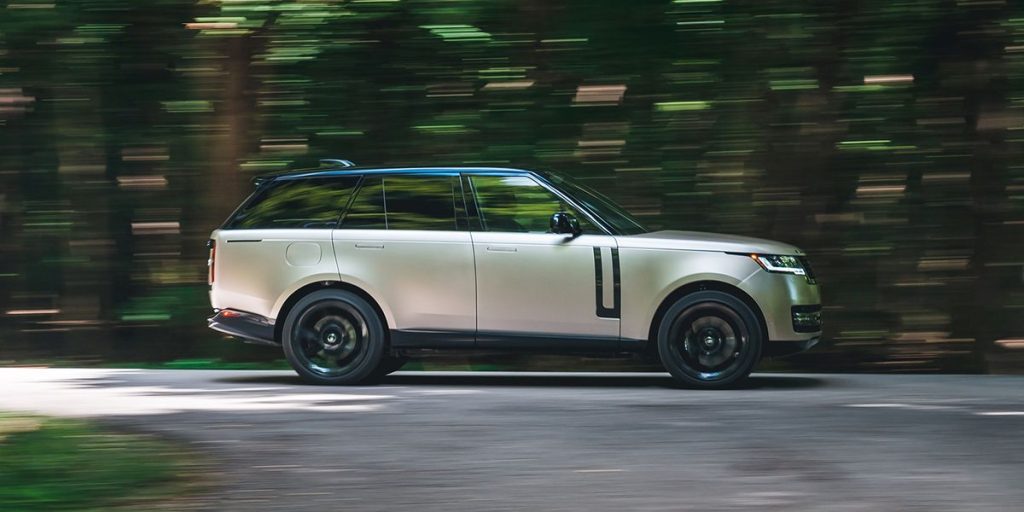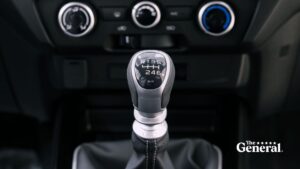Tested: 2022 Land Rover Range Rover First Edition Ups the Ante

From the November 2022 issue of Car and Driver.
In the beginning, the Range Rover’s appearance—upright profile, slablike body panels, unadorned sheetmetal—was the product of a utilitarian, function-driven design. The latest version’s evolved look is again upright, smooth, and simple, but for the opposite reason: The Range Rover has become an art object.
That’s as true of the interior as the exterior. The leather-everywhere cabin looks and feels like the environs of a six-figure automobile. As on the outside, the theme is seamless integration. The interior door handles are so smoothly integrated that first-time passengers often struggle to find them.
Marc Urbano|Car and Driver
In-cabin tech has the requisite modern depth and complexity. The seats’ massage function, for instance, requires its own menu page for choosing among 125 combinations of three settings: mode, area of focus, and intensity. Spelunking through the menus uncovers curiosities such as a dynamic info screen (g meter, lap-time recorder, stopwatch) and an air-quality page to activate the particulate filter, carbon-dioxide management, and the ionizer.
HIGHS: Looks like money inside and out, effortless thrust of the turbo V-8, still does Land Rover things.
For more common interactions, the 13.1-inch touchscreen—with or without haptic feedback enabled—is relatively easy to use and makes for a generous, sharply rendered full-screen map and crisp images from the multiple cameras. Footage includes views along the sides of the vehicle. Clearsight Ground View stitches together a virtual image of what’s immediately in front of and under the car.
The new model retains the Range Rover’s traditional regal seating position, with the base of the large side windows low enough that you can comfortably rest an elbow atop the door panel. Several rear seating configurations are offered. The biggest change with this generation is the arrival of three rows for the long-wheelbase version, and its adult-size rearmost seat has enough amenities to avoid feeling like steerage. Our standard-wheelbase test car had a bench seat for three, with the rightmost passenger getting a deployable leg-rest (which requires the front passenger’s seat to scrunch forward). The fully powered second row, however, doesn’t fold even remotely flat, compromising max cargo capacity.
Per Range Rover tradition, you access the cargo hold via an upper liftgate and a drop-down tailgate, both power-operated, as is the cargo cover. The no-cost Tailgate Event Suite option adds versatility by way of a panel in the load floor that corrals luggage when stood up. It also forms the back of the rear-facing “event seat”—just the thing for watching polo or your kid’s soccer practice. Activating Tailgate Event Suite mode opens the rear and directs stereo sound to the liftgate-mounted speakers.
While a carryover supercharged and turbocharged 3.0-liter inline-six is standard, our test car had the new BMW-sourced twin-turbo 4.4-liter V-8. Its subdued rumble is a tip-off to what’s under the hood, yet at 70 mph, the Rover’s cabin is a hushed 66 decibels. An initial stab at the accelerator can bring a greater forward lunge than desired. Otherwise, the long pedal travel, the engine’s linear response, and the eight-speed automatic’s demure shifts combine to make this a polished powertrain. Only the auto stop-start system’s restarts strike an awkward note. The V-8’s 523 horses and 553 pound-feet of torque easily animate 5982 pounds of British SUV. Sixty mph arrives in a fleet 4.3 seconds (matching the 682-hp Cadillac Escalade-V), and the quarter-mile passes in 12.8 seconds at 109 mph. The Rover’s heft is more evident when stopping, as it takes 185 feet to haul this big boy down from 70 mph.
LOWS: Genteel rather than sporty road manners, not the best transport for bulky items, six-figure starting price is merely a launching point.
For all the techno wizardry of a new five-link rear suspension, air springs, and active anti-roll bars, the default Auto terrain response mode still allows for near-constant nodding body motions over all but the smoothest tarmac. The sportiest Dynamic mode quells that to some degree without overly degrading ride quality—unlike in some German competitors—although the 23-inch wheels do clomp over impacts. In any mode, the creamy-smooth steering is light, and the heavy Rover lists in fast, sweeping curves. On the skidpad, we measured just 0.73 g worth of grip, limited by nondefeatable stability control, but the Rover pirouettes through parking lots thanks to its new rear-wheel steering.
Sadly, we didn’t test the seven off-road driving modes, the transfer case’s low range, or the 35.4-inch wading capability. A Range Rover may have extreme abilities, but much like a Rolex Submariner that’s waterproof to 1000 feet, that doesn’t mean it will use them. Once a mere utility vehicle, the Range Rover has become something more.
Specifications
Specifications
2022 Land Rover Range Rover First Edition
Vehicle Type: front-engine, 4-wheel-drive, 5-passenger, 4-door wagon
PRICE
Base/As Tested: $159,550/$169,900
Options: Sunset Gold Satin Finish $7450; Shadow Exterior Pack, $1000; black contrast roof, $1000; 23-inch gloss black wheels, $900.
ENGINE
twin-turbocharged and intercooled DOHC 32-valve V-8, aluminum block and heads, direct fuel injection
Displacement: 268 in3, 4395 cm3
Power: 523 hp @ 6000 rpm
Torque: 553 lb-ft @ 1800 rpm
TRANSMISSION
8-speed automatic
CHASSIS
Suspension, F/R: multilink/multilink
Brakes, F/R: 15.7-in vented disc/14.5-in vented disc
Tires: Pirelli Scorpion Zero All-Season
285/40R-23 117 M+S Extra Load LR
DIMENSIONS
Wheelbase: 118.0 in
Length: 198.9 in
Width: 80.6 in
Height: 73.6 in
Passenger Volume: 109 ft3
Cargo Volume: 41 ft3
Curb Weight: 5982 lb
C/D TEST RESULTS
60 mph: 4.3 sec
100 mph: 10.6 sec
1/4-Mile: 12.8 sec @ 109 mph
130 mph: 19.4 sec
150 mph: 30.3 sec
Results above omit 1-ft rollout of 0.3 sec.
Rolling Start, 5–60 mph: 5.1 sec
Top Gear, 30–50 mph: 2.9 sec
Top Gear, 50–70 mph: 3.5 sec
Top Speed (mfr’s claim): 155 mph
Braking, 70–0 mph: 185 ft
Braking, 100–0 mph: 373 ft
Roadholding, 300-ft Skidpad: 0.73 g
C/D FUEL ECONOMY
Observed: 16 mpg
75-mph Highway Driving: 23 mpg
75-mph Highway Range: 540 mi
EPA FUEL ECONOMY
Combined/City/Highway: 18/16/21 mpg
C/D TESTING EXPLAINED
This content is imported from OpenWeb. You may be able to find the same content in another format, or you may be able to find more information, at their web site.




